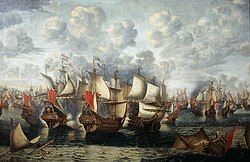Battle of the Sound
The Dutch, under the command of Lieutenant-Admiral Jacob van Wassenaer Obdam with Egbert Bartholomeusz Kortenaer as his flag captain, who had sailed to the Baltic in support of Denmark, had 41 ships with 1,413 guns while the Swedes, under Lord High Admiral Carl Gustaf Wrangel, had 45 ships with 1,838 guns.
The seven Danish ships with about 280 guns were unable to assist their Dutch allies because of adverse northern winds and could only watch.
He requested the orders to be given to him again "in three words", with de Witt replying with a single sentence: "Save Copenhagen and punch in the face anyone who tries to prevent it".
The Swedes attacked aggressively, but failed to gain the upper hand, primarily because the approaching Dutch had the weather gage.
During the 17th century, the Dutch Republic was a sailing nation with great trade interests; not least in the Baltic Sea.
On October 7, 1658, the large Dutch fleet set sail and nineteen days later, anchors were lowered north of the Sound, at a base called "Lappen".
Down in the Sound, by the island of Ven, the Swedish fleet consisted of 31 warships, 14 armored merchant ships, 1,838 guns and 6,649 men.
Paralyzed by gout, sitting on an armchair on deck, he was allowed to lead the battle from his admiral ship Eendracht.
In the end, the king hoped that the Dutch would side with the Swedes and greet Kronborg with a salute.
Wrangel was forced to interrupt the battle and the ship drifted helplessly across the strait towards Elsinore.
"Eventually the Swedish ship Wismar also came to it, lay down in front of the bow and thus the Dutchman was overpowered since the vice admiral with quite a lot of people up there was shot dead, the flag on it was taken down and it finally sank under the landside of Zealand."
In Swedish diary entries, it is noted that in the days after the battle, several flagpoles from masts could be seen sticking out above the water surface.
The Dutch broke through the Swedish blockade and were able to unite with the trapped Danish fleet in Copenhagen.
While ringing all the church bells in Copenhagen, the badly damaged Dutch ships slid towards the city.
In the morning, the day after the battle, orders were given that the damaged Swedish fleet would soon seek refuge in the deep channel next to Landskrona's fortress.



